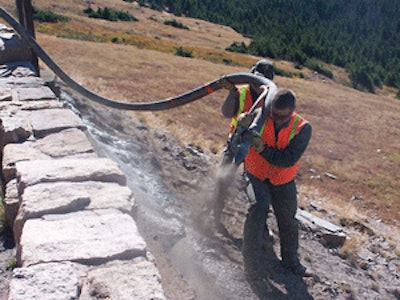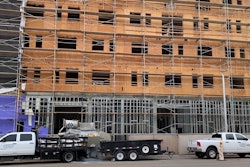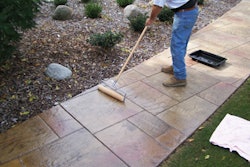
We all know concrete is a versatile material used in many different environments. But Dan Yeghoian, owner of DCY's Concrete Pumping Services, took that idea to new heights, literally. In September 2007, DCY completed a shotcrete job on Trail Ridge Road in Rocky Mountain National Park - 11,700 ft. above sea level.
Weather eroding underneath the roadway produced the need for shotcrete to be used as erosion control, according to Yeghoian. "They put rock in there, and then we shot concrete to seal the rock up so the water would shed over and stop eroding under," he says.
Yeghoian says he was originally approached about the job two years ago. When the concrete supplier backed out the project was put on hold. Then, at the beginning of this summer it looked like the project would be completed, according to Yeghoian. But again, the concrete supplier backed out. That's when Yeghoian suggested using an on-site mixer.
The project of 150 yards of roadway took only one day to complete using a shotcrete mix of 80 percent sand and 20 percent 3/8-in. thick pea gravel. Yeghoian says about 41,000 lbs. of cement was on site, but only 2/3 to 3/4 of that cement was used. Chicken wire was used in deep cavities to help hold the concrete in place.
The process DCY used was similar to any other shotcrete job it has done. The crew came to the jobsite, set up its Putzmiester concrete pump, attached the 2-in. hose and then started pumping. Aside from the site mixer, there was also a loader, water truck and a cement silo on site.
Yeghoian's job was to monitor the pump. "That was probably the hardest part of the job," he says. Because they were using a site mixer instead of a ready-mix truck, the mix was continually changing. "Controlling the concrete is the hardest thing, and when I'm doing shotcrete it's real critical that the concrete be workable. It can't be too dry, and it can't be too wet. It's got to be just right."
Weather conditions were also a concern at the jobsite. Colder temperatures caused the concrete to take a little longer to dry, Yeghoian says. The wind, which can gust between 50 and 70 mph in that area, is another consideration when using a nozzle to blast concrete onto rocks. DCY had to change the direction it was shooting in order to stop the concrete from blowing back into the nozzleman's face.
Despite the weather conditions, Yeghoian never hesitated to take on the Trail Ridge Road project. "I pump concrete for a living," he says. "The more difficult, the more challenging, the more fun."
Do you have a project you would like Concrete Contractor to consider for "On the Job"? E-mail your idea to Kim Johnston at [email protected].



















